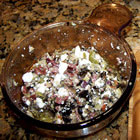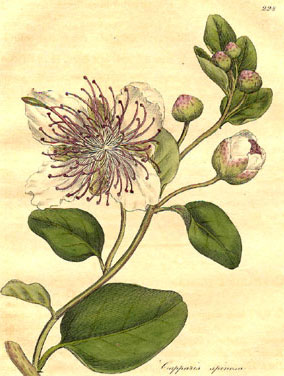Human Flower Project
Capers Everybody Having Some
By on February 28th, 2022 in
Friday, December 15, 2006
Capers: Everybody Having Some?
An unopened flower bud grows out of ancient walls and can kick modern-day ones down.
 Tapenade
Tapenade
Photo: About Home Cooking
They are kind of evil looking, or so we thought until learning that capers are actually the green buds of Capparis spinosa, a flowering plant of the Mediterranean. Our cousin Ben, who used to live in Positano, Italy, remembers caper bushes growing right out of the retaining walls of nearby almond orchards. Who scrambled up there, we wonder, to pick the buds before they bloomed?
According to one authority, the flower buds are sun-dried first, then pickled in brine. “The taste is slightly astringent and pungent, and they can lend piquancy to many sauces and condiments.” That’s putting it mildly. Their flavor is so powerful and lasting that social occasions where they’re served require a pact: we’re all eating this, and whoever backs out will turn green.
 Capparis spinosa
Capparis spinosa
Image: Jan Meemelink
Cooking expert Lydia Walshin reports that capers “pair well with artichokes, fish, fatty meats like lamb, olives, potatoes, and tomatoes, and are an essential component of tapenade. The taste is fresh, salty, pungent, and slightly flowery-lemony.” When you put it that way, we’re on board.
Since capers are harvested and bitten in the bud, who’s ever seen the flowers? Here they are. It turns out they’re quite beautiful: pink, with cat-like whiskers. The flowers seem to be as short-lived as the buds are long-tasting. This link from Purdue describes medicinal uses of capers, some of which should not be mentioned in polite conversation. Let’s just say they’re beneficial, high and low.
We’re planning to try some tapenade on guests tomorrow night—right after everyone agrees to the pact. This recipe comes from The Meat and Potatoes Cookbook, as adapted by Robin Robertson:
Look for good-quality, brine-cured olives, not the canned supermarket variety.
If using a food processor instead of the traditional mortar and pestle, be careful not to overprocess – the tapenade should retain some texture. Both large, meaty Kalamata olives and the smaller, sweet Gaeta variety are great in this recipe.

Capparis spinosa growing from a wall in Palma de Mallorca, Spain
Photo: Jardin Mundani
INGREDIENTS
1 1/2 cups Kalamata or Gaeta olives, pitted
3 tablespoons capers, drained
2 garlic cloves, finely minced
1/4 cup minced fresh parsley leaves
1/2 teaspoon salt
1/8 teaspoon freshly ground black pepper
1/4 cup extra virgin olive oil
In a food processor or mortar, combine the olives, capers, garlic, parsley, salt, and pepper. Slowly add the oil and pulse or work with the pestle into a coarse paste, retaining some bits of olive and caper for texture. Taste to adjust the seasonings. Stored tightly covered in the refrigerator, this will keep well for a week or two.
Makes about 2 cups




